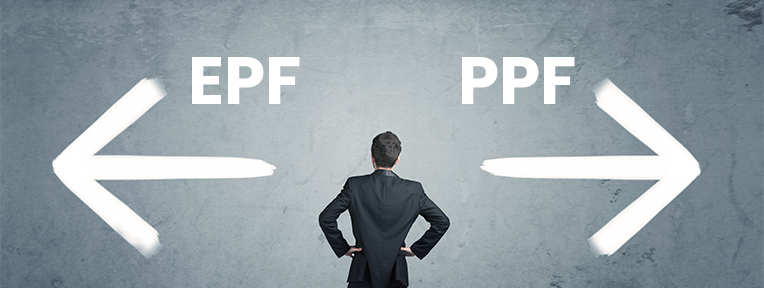
Difference Between EPF and PPF
Posted on Monday, November 11th, 2024 | By IndusInd Bank
Are you confused about choosing between the Public Provident Fund (PPF) and Employee Provident Fund (EPF) schemes? Both are prudent savings schemes but serve distinct goals. Choosing between both options depends on your financial goals and employment status.
EPF is mandatory for salaried employees and involves contributions from both the employee and the employer. Conversely, PPF is a voluntary investment product offering tax advantages and is favourable for anyone looking for a risk-free, long-term savings plan.
You can make a more informed decision by understanding the key differences between EPF and PPF. Let’s dive into these schemes and explore their unique features, making it easier for you to align them with your financial objectives.
What are EPF and PPF?
EPF is a retirement savings product specifically tailored for salaried employees. Both the employee and employer contribute to this fund, making it a reliable method to establish a considerable retirement corpus over time. For employees earning up to ₹15,000 basic salary per month in organisations with over 20 employees, participation in EPF is mandatory.
This makes it an important component of financial planning for salaried. When debating EPF vs PPF, it is essential to note that EPF is designed for those in formal employment, ensuring steady contributions throughout their working years.
PPF, in contrast, is open to everyone, irrespective of their employment status. This makes it a versatile product for both self-employed and salaried individuals who wish to secure their financial future. Unlike EPF, PPF is a voluntary savings instrument, meaning individuals can select when and how much they want to invest.
This flexibility makes PPF an enticing choice for long-term wealth creation, particularly for those not covered under formal employment schemes. In comparison of PPF vs EPF, PPF stands out for its accessibility to a broader range of investors, offering an opportunity for everyone to concentrate on retirement planning.
Differences Between EPF and PPF
EPF is a retirement savings product specifically for salaried employees, while PPF is a government-backed investment option available to all Indian residents. Here are the key distinctions between PPF and EPF:
1) Interest Rates and Returns
EPF interest rates are fixed by the government and tend to be higher than many other savings options, currently 8.25% per annum. This makes EPF a reliable choice for steady returns.
PPF also provides government-set interest rates. Currently, the interest rate stands at 7.1%. Although slightly lower than EPF, the interest is compounded annually, helping your savings grow gradually over time.
2) Tax Benefits
In the case of EPF, the contributions are eligible for deduction under Section 80C of the Income Tax Act, 1961, and the interest and maturity amount are tax-exempt, making EPF a tax-friendly investment.
PPF contributions also qualify for tax deductions under Section 80C. Additionally, the interest earned and the maturity proceeds are also free of tax if certain conditions are met.
3) Flexibility and Liquidity
EPF withdrawals are restricted and typically allowed at retirement or for particular purposes like purchasing a home or medical exigencies.
Partial withdrawals in PPF are permitted after the seventh year and you can take a loan against your PPF balance. This makes PPF more flexible for those requiring liquidity.
For more flexibility and to complement your EPF or PPF savings, open a savings account online. Go for the Indus Multiplier Max Savings Account by IndusInd Bank. This Fixed Deposit (FD) linked savings account offers:
| Feature | Overview |
| Open instantly | Use your Aadhaar and PAN to open an account instantly |
| Dual benefits | Enjoy the flexibility of a savings account along with higher returns on FDs |
| Higher returns on FD | Earn higher interest through the feature of Indus Smart Sweep |
| 25% off on lockers | Avail 25% off on locker charges for the first year |
In case you are looking for a zero-balance account for greater flexibility in managing your funds, then you can consider the Indus Delite Savings Account.
Also Read: Open Your Savings Account in 4 Easy Steps
Ending Note
Understanding the difference between EPF and PPF is essential for aligning them with your financial goals. EPF is suited for salaried individuals looking for a structured retirement savings plan, while PPF offers a flexible, long-term investment avenue open to everyone.
By complementing these investment schemes with a savings account like the Indus Multiplier Max Savings Account, you can further enhance your financial strategy, enjoying both higher returns and flexibility. Whether you are saving for retirement or just looking to grow your wealth, being aware of all the options available allows you to make the most financially sound and informed decision.
So, do not wait any longer, take control of your financial future and open an Indus Multiplier Max Savings Account today!
Disclaimer: The information provided in this article is generic in nature and for informational purposes only. It is not a substitute for specific advice in your own circumstances. Hence, you are advised to consult your financial advisor before making any financial decision. IndusInd Bank Limited (IBL) does not influence the views of the author in any way. IBL and the author shall not be responsible for any direct/indirect loss or liability incurred by the reader for taking any financial decisions based on the contents and information.



 Offers
Offers Rates
Rates Debit Card Related
Debit Card Related Credit Card Related
Credit Card Related Manage Mandate(s)
Manage Mandate(s) Get Mini Statement
Get Mini Statement
 categories
categories Bloggers
Bloggers Blog collection
Blog collection Press Release
Press Release


